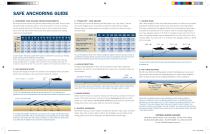
Catalog excerpts

SAFE ANCHORING GUIDE 1. DETERMINE YOUR HOLDING POWER REQUIREMENTS Be sure that your anchor can give the performance you need. A lunch hook should be able to hold your boat in a 15-knot breeze. A main, or working anchor should hold up to 30-knots of wind. A storm anchor is for winds up to 42-knots. Remember that as the wind speed doubles, the holding requirement quadruples! WIND SPEED BOAT LENGTH Use the handy “Horizontal Loads Table” above to determine in pounds your holding power requirements for different wind speeds. NOTE: This table assumes boats of average beam and windage. If your boat has above-average beam or windage, refer to loads for the next larger size boat. The numbers in columns for feet = lbs. and the numbers in the columns for meters = kg. 2. USE ADEQUATE SCOPE Scope is the length of anchor line relative to the distance from your boat’s deck to the sea bottom. We recommend at least 5:1 scope. 20 FT. (6M) 3. “POWER SET” YOUR ANCHOR Know that your anchor is properly set! Back down very, very slowly. Then as the anchor begins to set, very slowly increase the load with your engine. Backing down at a faster speed may not give your anchor a chance to dig in and bury itself. TRUE DISPLACEMENT HULLS Ib. (SHAFT HP X 20) kg. SEMI DISPLACEMENT HULLS lb. kg. (SHAFT HP X 15) FAST, PLANING HULLS (SHAFT HP X 10) SCOPE HOLDING POWER In crowded anchorages, “Power Set” your anchor at 5:1 scope, then shorten scope as required. Remember that your depth sounder may be giving you the water depth under your keel rather than from the true waterline, in which case you need to add your draft plus the height of your deck when calculating scope. table above to determine just how hard your boat can “Power Set” your anchor. 4. ANCHOR RESETTING In areas of changing tide or wind, set two anchors off the bow in opposite directions. Any anchor can occasionally fail to reset once it has been pulled out of the bottom. WIND CURRENT Don’t be fooled by some manufacturers’ claims about any anchor’s ability to dependably At 10:1 the holding power will double, and at less than 3:1, you will give up a You can simulate the force of the wind by using your engine’s thrust to set your anchor to “BAHAMIAN” MOORING 7. ANCHOR RODE Use a short length of chain and three-strand nylon line. Nylon is very elastic and greatly reduces shock loads on your boat and its anchoring system. The chain protects the line against chafe from the seabed and also helps to provide a horizontal pull on the anchor when it is initially beginning to set. If you regularly anchor in 25 ft (8 m) of water or less, use 6 ft (2 m) of chain. For greater depths, use an additional 6 ft (2 m) for every 25 ft (8 m) of water depth, e.g. use 24 ft (7 m) of chain if you regularly anchor in 100 ft (30 m) of water. 5. ANCHOR RETRIEVAL Slowly move the boat to a position directly over the anchor, pulling in the line as you go. Then snub the line on a cleat and power backwards slowly to pull the anchor out of the bottom. Do not power forward because that will require more energy and will put very heavy loads on the anchor and gear. 6. SUPPORT HARDWARE Remember that your anchor system includes the shackle, rope, chain, and deck cleats. Every item must be able to deliver the strength you need. Refer to the All chain anchor rodes lack the shock absorbing ability of nylon rope when the windpipes up! All soft mud bottoms offer greatly reduced holding power, so be sure your anchor can provide the holding power you need. Some bottoms SETTING PROBLEM TRY SHORT SCOPE 2:1 OR 3:1 COMMON BOTTOMS 32° ANGLE SOFT MUD BOTTOMS 45° ANGLE Some soft mud bottoms have a sticky consistency which makes setting any initially at a very short scope, e.g. 2:1. Then increase the scope to at least 5:1 and “Power Set” the anchor. Special Mud Palms are included for both Fortress® and Guardian® anchors to aid setting in very soft, problem mud. We recommend that you permanently install the Mud Palms on your anchor, as they help the anchor set faster in any type of bottom. FORTRESS MARINE ANCHORS 1386 West McNab Road . Fort Lauderdale, Florida, USA 33309 Tel: 800-825-6289 (USA) . 954-978-9988 . Email: info@fortressanchors.com
Open the catalog to page 1All Fortress Marine Anchors catalogs and brochures
-
Fortress Selection Guide
1 Pages



